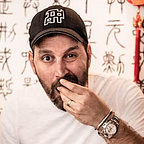My Creative Identity Is For Sale On A Blockchain.
“The flourishing of information technology gives amateurs and home recording artists powerful tools to build and share interesting, transformative, and socially valuable art drawn from pieces of popular cultures. There’s no place to plug such an important cultural sea change into the current legal regime.” — Jonathan Zittrain, professor of Internet law at Harvard Law School, discussing the Grey Album
I’m not an artist.
I don’t mean that the way people mean it when they say “I can’t draw.” because they’ve never really tried, or because they really can draw and they want to surprise you. I am not an artist because I think art is (usually) fraudulent and I don’t want to be associated with it.
(Author’s note: In some ways, I present as an “artist”. I have a Bachelor of Fine Art degree, my name has appeared on the walls of major American museums including MOMA, The Museum of Contemporary Art LA, the New Museum and I’ve shown at Sundance and Tribeca all for non-commercial “art” projects. I frolicked Williamsburg, I started a communal artists loft in Bushwick, I’ve danced onstage at Lincoln Center and I’m a trained mime. But, I’ve never said I’m an artist, although I have at times implied it with my facial hair and choice of hat.)
People like to talk about the value of art like everything is a finger painting that must be celebrated and somehow it’s all special because it comes from the heart. But, art that isn’t therapy or made for play is almost always created for commercial purposes (the Picassos and the Michael Jacksons). And if it’s made for pure creative expression it only becomes “art” when it becomes popular and/or generates revenue posthumously (the Van Gogh’s and Daniel Johnston’s). The difference between being labelled an artist and having a hobby is pure marketing and I want none of it. Well…… I WANTED none of it.
If good art is art that has an audience and makes money, it means that people who call themselves artists are merchants, vendors and marketing professionals. It also means that the broad adoption of NFTs is actually the true beginning of real art.
I’m here to say that selling out is selling art, and NFTs allow us to finally be honest with ourselves about the value of creativity and commerce.
Distributed ownership of creative output means that for the first time in history, we can quantify our collective appreciation for art in real time by paying for it. NFTs allow us to share creative output with the world and have a constant non-fungible metric for how good it is.
So, I’ve made an NFT, chosen an artist name from an Iggy Pop song, included a picture of myself with a mustache and posted the work on Rarible. It’s a conceptual piece that I put very little work into, but I like it and think it is pretty clever. But, that’s irrelevant. Only you can decide if it’s art and if it’s revolutionary if you decide to pay for it.
If anyone invests actual money into owning my NFT “Orange You Glad™”, I will call myself an artist, because I will have finally made art that is quantifiably good, not just something I think is pretty. I’ll also refer to my output in advertising is art, because I find it hard to understand the difference.
Below is an excerpt from the artist’s statement as it appears on Rarible:
ARTIST STATEMENT
Orange You Glad™ is a self-portrait and commentary on my own creative identity.
I’ve never said I am an artist. That all changes with this banana which I’ve artfully designed to embody a sort of irreversible dialectic about the nature of identity and then later used in a smoothie.
Like this banana, poisoned and ultimately disfigured by an act of creativity, I myself have been deeply affected and ultimately transformed by my tenure as a professional creative person. This piece is my way of becoming an artist, a worthless title IMO, until someone is willing to pay for it.
PROCESS:
This banana has been treated with a Sharpie and through osmosis absorbed the marker’s chemicals. The marker’s chemicals are designed to render permanently on any surface. But, in this case, the banana itself transmogrified the ink into a sort of poison. The marks made by the Sharpie have sped the decomposition of the banana, embedding themselves in its flesh as indelible bruises and mortal wounds. This act of art as self-flagellation is made doubly impactful as the words themselves transition the very nature of banana to an orange which it can’t be and yet has become. It’s as if art itself has wounded the banana into becoming the thing it is not, and in doing so sped it towards its inevitable demise (in this case in a smoothie made in collaboration with other fruit and also kale).
